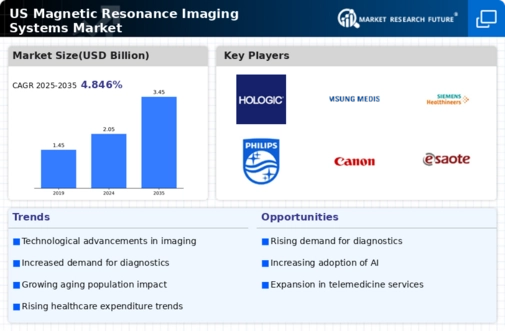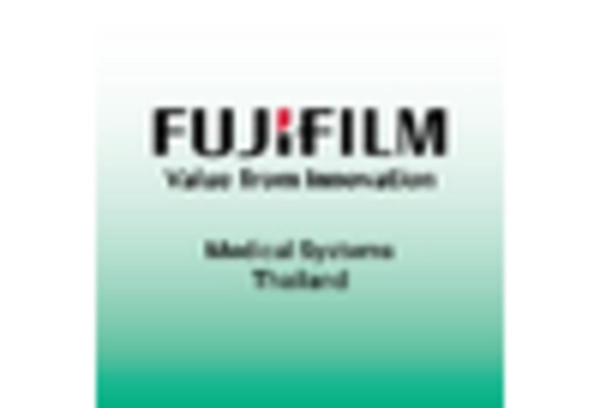Rising Prevalence of Chronic Diseases
The increasing incidence of chronic diseases such as cancer, cardiovascular disorders, and neurological conditions is a primary driver for the magnetic resonance-imaging-systems market. As healthcare providers seek advanced diagnostic tools to improve patient outcomes, the demand for MRI systems is expected to rise. According to recent data, chronic diseases account for approximately 70% of all deaths in the US, highlighting the urgent need for effective diagnostic solutions. This trend is likely to propel investments in MRI technology, as hospitals and clinics aim to enhance their diagnostic capabilities. Furthermore, the aging population, which is more susceptible to these conditions, is anticipated to further boost the demand for MRI systems, thereby shaping the future landscape of the magnetic resonance-imaging-systems market.
Expansion of Outpatient Imaging Centers
The expansion of outpatient imaging centers is emerging as a significant driver for the magnetic resonance-imaging-systems market. These facilities offer convenient access to diagnostic imaging services, catering to the increasing demand for non-invasive procedures. As patients seek alternatives to traditional hospital settings, outpatient centers are likely to proliferate, necessitating the acquisition of advanced MRI systems. Recent data indicates that the outpatient imaging market is expected to grow at a CAGR of over 5% in the coming years. This trend not only enhances patient access to MRI services but also stimulates competition among providers, ultimately benefiting the magnetic resonance-imaging-systems market.
Technological Integration in Healthcare
The integration of advanced technologies such as artificial intelligence (AI) and machine learning into MRI systems is transforming the magnetic resonance-imaging-systems market. These innovations enhance image quality, reduce scan times, and improve diagnostic accuracy. For instance, AI algorithms can assist radiologists in identifying anomalies, potentially increasing the efficiency of MRI procedures. The market for AI in medical imaging is projected to grow significantly, with estimates suggesting a compound annual growth rate (CAGR) of over 30% in the coming years. This technological evolution not only improves patient care but also drives the adoption of MRI systems across various healthcare settings, indicating a robust growth trajectory for the magnetic resonance-imaging-systems market.
Increased Focus on Early Disease Detection
The heightened emphasis on early disease detection and preventive healthcare is driving the magnetic resonance-imaging-systems market. As healthcare providers recognize the importance of early diagnosis in improving treatment outcomes, the demand for advanced imaging technologies, including MRI, is expected to rise. Studies suggest that early detection can significantly reduce treatment costs and improve survival rates for various conditions. This shift towards proactive healthcare is likely to encourage investments in MRI systems, as they play a vital role in identifying diseases at their nascent stages. The magnetic resonance-imaging-systems market is thus positioned to benefit from this growing trend, as healthcare systems prioritize early intervention strategies.
Growing Investment in Healthcare Infrastructure
The ongoing investment in healthcare infrastructure in the US is a crucial driver for the magnetic resonance-imaging-systems market. As hospitals and diagnostic centers expand and upgrade their facilities, the demand for state-of-the-art imaging equipment, including MRI systems, is likely to increase. Recent reports indicate that healthcare spending in the US is projected to reach $6 trillion by 2027, with a significant portion allocated to medical imaging technologies. This influx of capital is expected to facilitate the acquisition of advanced MRI systems, thereby enhancing diagnostic capabilities and improving patient outcomes. Consequently, the magnetic resonance-imaging-systems market is poised for substantial growth as healthcare providers respond to the evolving needs of the population.

















Leave a Comment